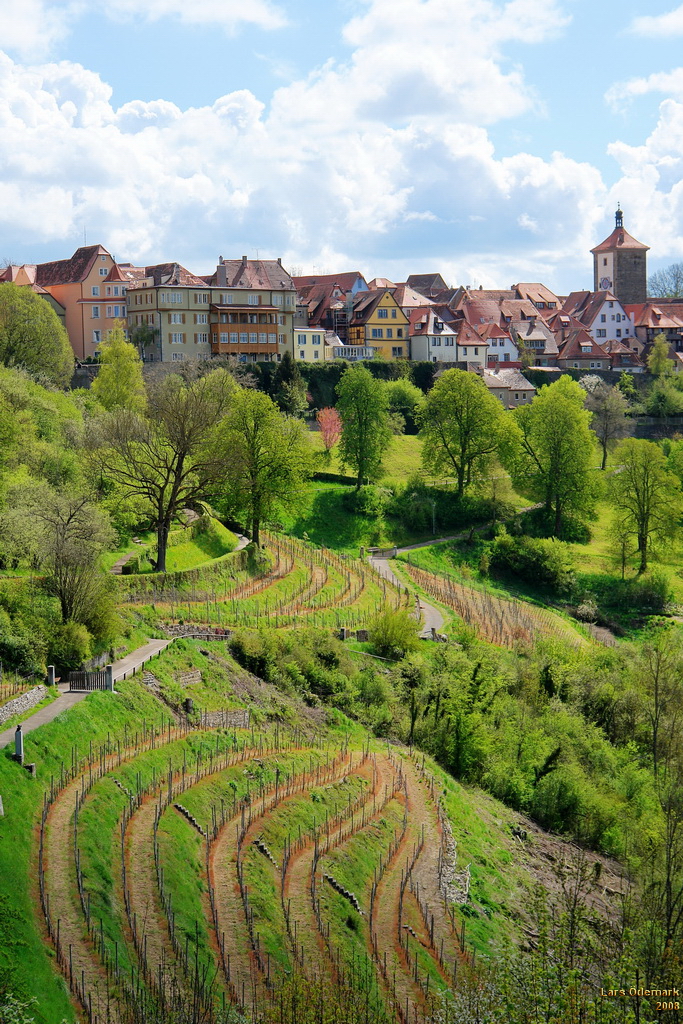Weingut Hofmann, Tauberschwarz Propstberg R, 2007
Time to go regional on you again, with a grape variety hardly ever talked or thought about outside of the roughly 35 acres of land where people actually grow it. Tauberschwarz literally translates as "River Tauber black". While this does seem to provide a first tentative clue about the colour of the wine, a bit more remains to be explored: A bit more about what Weingut Hofmann, an estate that specialises in the all-but-forgotten grape, has brought to the bottle, and a bit more about the vinous backwater that has conserved this endangered species.  Obviously, colour has to be the first talking point about the Propstberg: I would call it a very dark cherry red, a lot darker than any German Pinot Noir surely, but in no way black. In the smell, I get ripe sour cherries, a little overripe and tannic sour cherries actually, but also a refreshing note of herbal dryness. On the palate it's cherries again, with a variety of dried fruit, while assertive tannins and fresh acidity provide some character and make the wine's body seem much lighter than the actual 13.5%. It's not an outstanding or endlessly memorable wine, but a thoroughly original and enjoyable little red. Stylistically, people with a weakness for traditional Chianti Classico or maybe good Beaujolais should find it particularly satisfying. But what about its home? The Tauber valley is not unknown in the wider world. Its picturesque medieval walled cities and towns, notably Rothenburg ob der Tauber, and generations of tourists and cyclists have seen to that. But recognition as a wine growing region in its own right has so far largely eluded it. Germanic sense of order may have something to do with this: The valley is shared by three wine regions: Franken, Württemberg and Baden [*]. This division makes little sense, and is probably not in the best interest of the region's brand, because it divides a fairly homogenous micro-region between larger appellations whose centres are elsewhere. Apart from Tauberschwarz, their unique selling proposition, Tauber valley vineyards produce mostly Müller-Thurgau, Pinot Meunier and Silvaner. Quality seems to be fairly solid across the board, although without any outstanding multi-starred estates that could successfully push into export markets.
Obviously, colour has to be the first talking point about the Propstberg: I would call it a very dark cherry red, a lot darker than any German Pinot Noir surely, but in no way black. In the smell, I get ripe sour cherries, a little overripe and tannic sour cherries actually, but also a refreshing note of herbal dryness. On the palate it's cherries again, with a variety of dried fruit, while assertive tannins and fresh acidity provide some character and make the wine's body seem much lighter than the actual 13.5%. It's not an outstanding or endlessly memorable wine, but a thoroughly original and enjoyable little red. Stylistically, people with a weakness for traditional Chianti Classico or maybe good Beaujolais should find it particularly satisfying. But what about its home? The Tauber valley is not unknown in the wider world. Its picturesque medieval walled cities and towns, notably Rothenburg ob der Tauber, and generations of tourists and cyclists have seen to that. But recognition as a wine growing region in its own right has so far largely eluded it. Germanic sense of order may have something to do with this: The valley is shared by three wine regions: Franken, Württemberg and Baden [*]. This division makes little sense, and is probably not in the best interest of the region's brand, because it divides a fairly homogenous micro-region between larger appellations whose centres are elsewhere. Apart from Tauberschwarz, their unique selling proposition, Tauber valley vineyards produce mostly Müller-Thurgau, Pinot Meunier and Silvaner. Quality seems to be fairly solid across the board, although without any outstanding multi-starred estates that could successfully push into export markets.

* Fun facts for historical geography buffs: In the Napoleonic shake-up of the Holy Roman Empire, the free imperial city of Rothenburg and the area around it were first to go, grabbed by Bavaria in 1803. The northern part of the Tauber area, originally a mixture of church and princely lands, was awarded to the Grand Duchy of Baden in 1806 after some to and fro, and stayed with it even beyond the Baden and Württemberg merger of 1952. The rest of the region, including the city of Mergentheim, last headquarters of the order of Teutonic knights, was taken over by the newly created kingdom of Württemberg. The boundaries were only redrawn in Baden-Württemberg's administrative reform of 1972, when all of the Tauber area except for the Bavarian districts became part of Württemberg. That last bit is not even technically true, because neither 'Baden' nor 'Württemberg' are formal subdivisions of today's unitary 'Land'. In any case, the geography of church districts and all kinds of commercial boards and associations, and in our case wine growing regions, continue to reflect these older boundaries. Anybody still awake? Here's another nice picture to get your mind off these pointless ramblings:

